|
jehovajah
|
 |
« on: April 06, 2013, 03:11:29 PM » |
|
Recently i made a paradigm shift from Particle-wave mechanics (?) to fluid mechanics asthe basis of my model of the observables of natural philosophy. I have basically finished my review of the foundation of mathematics and found myself questing in the area of Electromagnetism, inspired by Maxwell's (so called) Equations. The Grassmanns have been my intermittent study for a while, but i keep getting inspired by something they say and get diverted! Nevertheless i have to return to the Ausdehnungslehre at some stage, but for now i want to look at Helmholtz, Lord Kelvin, Maxwell Tait, and Friedmann, and Kolmogrov as an application of Grassmann Hamilton Clifford reference frames, although i have only cursorily approached Clifford's work. There is a problem in Turbulence i want to look at by means of fractal generation apps, as i do not believe you need a Cray supercomputer to model boundary layer fluid dynamics. A straightforward quaternoin based fractal generator should give some insight. My initial proposition is to make lines of vorticity fundmental. Strreamlines will be constituted from lines of vorticity. 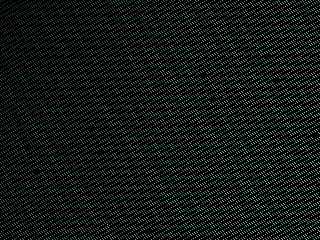 Fluids are counter intuitive, which is what i have learned to love. These lines of vorticity are the radii of spheres about any distinguished centres. Thus a stream line is a line of these vorticity bubbles, where the radii that follow a "stream" are distinguished. Because of printing/plotting constraints i restrict the lines of vorticity to orthogonal axes plus a resultant axis of rotation( hence quaternions). The boundary limit constraints act as a conjugating region. a focal region for study. i have trialed a intuitive notion of a streamline equation/profile for iterative generation, but i write for Terry Gintz Quasz, so i will have to modify it for anyone else. This particular trial image restricts the lines of voricity to a plane. i have a 3d version i will load tomorrow. 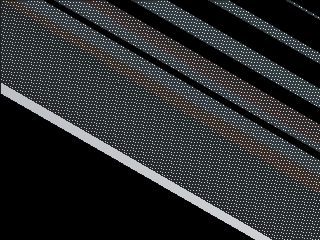 |
|
|
|
« Last Edit: April 10, 2013, 06:21:48 AM by jehovajah »
|
 Logged
Logged
|
May a trochoid of ¥h¶h iteratively entrain your Logos Response transforming into iridescent fractals of orgasmic delight and joy, with kindness, peace and gratitude at all scales within your experience. I beg of you to enrich others as you have been enriched, in vorticose pulsations of extravagance!
|
|
|
|
jehovajah
|
 |
« Reply #1 on: April 07, 2013, 02:09:58 AM » |
|
The first principle is that the lines of vorticity are a fractal distribution at all scales and the quantity of vorticity when defined, will be assumed to take a Gauss Maxwell Boltzman distribution in an observable space in which the factors of Lubricity/viscosity,densityand pressure are attributed.
The second principle is that these magnitudes are functions of vorticity. Thus the lubricity/viscosity measure and the density measure to be defined will take vorticity and the distribution of vorticity as arguments, and the regional pressure will take vorticity, viscosity/lubricity and density as arguments.
i will define a centre as an arbitrary region in space that i am aware of.
Between 2 distinguished centres i will construct a spherical spaciometry by which i will define a metron as a fixed displacement(the 2 centres) a plane of dual centres as points and a line of dual points as a straight line, This arbitrary straight line will be my fundamental axis.
Rotation around the centres will be used to define a conical rotation around the fundamental axis. This conical rotation is defining the concept of vorticity.
The concept of rotation will be more general than movement on a spherical or conical surface that is "circular" any closed or open movement on a conical or spherical surface that returns to its point of origin is a rotation. In particular if an elastic straight line is attached to the moving region and its origin of motion, that line will sweep out a surface that is conelike however warped.
The use of an axis to define vorticity means we can relate rotational motions to positional displacements. When this is done it should be clear that rotational motion does not resolve into motion around and axis. it resolves into oscillatory motions on arcs in general relative to a given axis or surface.
We may resolve vorticity into a number of ways, but the praxis is to use whatever makes it easier to analyse and describe the motion.
For example, for the mandelbulb we regularly switch between cartesian and polar representations.
To include vorticity then i need to add a dynamic addition to the the positional coordinates,
|
|
|
|
|
 Logged
Logged
|
May a trochoid of ¥h¶h iteratively entrain your Logos Response transforming into iridescent fractals of orgasmic delight and joy, with kindness, peace and gratitude at all scales within your experience. I beg of you to enrich others as you have been enriched, in vorticose pulsations of extravagance!
|
|
|
|
jehovajah
|
 |
« Reply #2 on: April 08, 2013, 02:35:41 PM » |
|
It is traditional in fluid mechanics to define what a fluid is.
A fluid is not a continuum.
It is a region of space, usually conjugated, which consists in fractally distributed regions at all scales.
With regard to motion these regions are free to move rotationally relative to any other region but constraints on those relative rotational motions will define the phases of matter.
a solid is a phase in which the regions have a fixed relative displacement with no freedom of rotation
A liquid is a phase in which the regions have a fixed relative displacement but are free to rotate around any region relatively, according to the constraint
Any other phase of matter has no fixed upper displacement but may have a fixed lower displacement relative to any other region and is free to rotate relative to any other region
It is assumed that each fractal region has its own local reference frame relative to which the region may rotate but affected by the constraints relative to other region.
I will modify the word fixed to a constrained displacement with an upper and lower bound dependent on the definition of substance as a perception of these observable behaviours of fluids.
Their are other attributes which also define this motion constraint but these are substantive. I refer to density, viscosity, lubricity and elasticity. Permitivity or permeability may be defined in terms of these 3, and diffusion as a state density distribution of distinguished fractal regions/
The motive principles behind these descriptions are essentially newtonian unless specifically designated.
Substances, when defined will include electric and magnetic as essential material substances found universally in an assumed structure i have recently decided upon.
|
|
|
|
|
 Logged
Logged
|
May a trochoid of ¥h¶h iteratively entrain your Logos Response transforming into iridescent fractals of orgasmic delight and joy, with kindness, peace and gratitude at all scales within your experience. I beg of you to enrich others as you have been enriched, in vorticose pulsations of extravagance!
|
|
|
|
jehovajah
|
 |
« Reply #3 on: April 10, 2013, 08:15:01 AM » |
|
s=imaj(z)
z=x#+(x#+y#+s+x#*y#*sin(x#))*i+ (x#+y#+s+x#*x#*cos(x#))*j+(x#+y#+s+x#*s*sin(x#)*cos(x#))*k+0.1*c
The trial vorticity streamline equation for Quasz.
This is not a movie but a snapshot of the space distribution after so many iterations. As with all fractal images it is a "negative" sculpture. What is actually moving under the iteration is "cut away" by the boundary condition and highlighted by the colouring algorithm within certain bounds.
The colouring algorithm is fundamental to grasping what may be happening under the iterations. Stepping through the iterations will give some insight.
The movement of the points is not natural in this test equation, it is highly specified. This is because the movement through the quaternion block is highly specified by the for loops. However, this whole approach tells me something about the relative movement of the points under iteration if the next position is given by the equation.
each point (y,s,w)in the quaternion block{ All( x,y,s,w)} moves by its coordinates plus a wobble at each iteration. The wobble i have kept simple, but of course you can make it exponential or Lissajous etc. every parameer is placed in the equation so that it can be tinkered with. So swop them round set some to constants etc.
i try julia and mandelbrot iterations even though this is not a mandelbrot form yet. The idea is to understand these types of equations to see if a vorticity distribution is apparent.
On the face of it , in julia form c represents a constant velocity profile so hence the factor in front of it. In the mandelbrot type it can be varied as that is the main variable profile descriptor and makes z a recursive function of c, Z(c,z(c)), while the julia is a recursive function of z, Z(z)
|
|
|
|
« Last Edit: April 10, 2013, 09:01:53 AM by jehovajah »
|
 Logged
Logged
|
May a trochoid of ¥h¶h iteratively entrain your Logos Response transforming into iridescent fractals of orgasmic delight and joy, with kindness, peace and gratitude at all scales within your experience. I beg of you to enrich others as you have been enriched, in vorticose pulsations of extravagance!
|
|
|
|
jehovajah
|
 |
« Reply #4 on: April 14, 2013, 09:29:05 AM » |
|
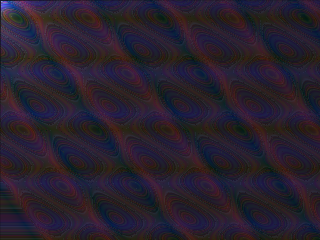 The colour scheme is not great but i hope you can see the whorls within a vorticity streamline . The equation i used is a polar form of the streamline equation, but i neede to pick the correct colouring algorithm to show all the dispositions in the Quaternion block [rfun r=x#+0.01*sin(pi*x#/2) p=y#+0.01*cos(pi*y#/4) o=imaj(z)+0.01*sin(pi*imaj(z)/6 rend z=r+(r*sin(p*1)*cos(o*1))*i+ (r*sin(1*p)*sin(1*o))*j+(r*cos(1*p))*k+4.405*c Again everything is meant to be varied. |
|
|
|
« Last Edit: April 30, 2013, 03:10:23 AM by jehovajah, Reason: rend in wrong place »
|
 Logged
Logged
|
May a trochoid of ¥h¶h iteratively entrain your Logos Response transforming into iridescent fractals of orgasmic delight and joy, with kindness, peace and gratitude at all scales within your experience. I beg of you to enrich others as you have been enriched, in vorticose pulsations of extravagance!
|
|
|
|
jehovajah
|
 |
« Reply #5 on: April 17, 2013, 02:09:10 PM » |
|
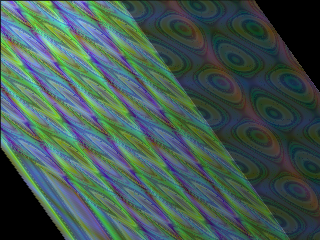 This image seems to be clearer and gives a depth view. Depending on colouring algorithms vorticity lines seem to make good candidates to replace streamlies. I have to figure out how to get two vorticity streams in opposite directions from the same block, and then how to collide them! |
|
|
|
|
 Logged
Logged
|
May a trochoid of ¥h¶h iteratively entrain your Logos Response transforming into iridescent fractals of orgasmic delight and joy, with kindness, peace and gratitude at all scales within your experience. I beg of you to enrich others as you have been enriched, in vorticose pulsations of extravagance!
|
|
|
|
jehovajah
|
 |
« Reply #6 on: April 24, 2013, 12:21:35 PM » |
|
|
|
|
|
|
 Logged
Logged
|
May a trochoid of ¥h¶h iteratively entrain your Logos Response transforming into iridescent fractals of orgasmic delight and joy, with kindness, peace and gratitude at all scales within your experience. I beg of you to enrich others as you have been enriched, in vorticose pulsations of extravagance!
|
|
|
|
jehovajah
|
 |
« Reply #7 on: April 25, 2013, 12:11:50 AM » |
|
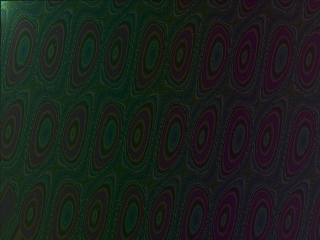 This equation is again for all variations. Will it fit as a model for any observed flow marks on sediments? [rfun s=imaj(z) rend z=x#+e^(sin(x#))*cos(y#)*cos(s)*i+e^(sin(y#))*cos(y#)*sin(s)*j+e^(sin(x#))*sin(y#)*k+0.0*c Again, there are traces of the Kelvin -Helmholtz patterns. and a deep zoom shows the pattern reforming, which is characteristic of turbulence. These highly structured freeze frames are interesting but clearly not instructive yet. |
|
|
|
« Last Edit: April 30, 2013, 03:11:35 AM by jehovajah, Reason: rend incorrectly placed »
|
 Logged
Logged
|
May a trochoid of ¥h¶h iteratively entrain your Logos Response transforming into iridescent fractals of orgasmic delight and joy, with kindness, peace and gratitude at all scales within your experience. I beg of you to enrich others as you have been enriched, in vorticose pulsations of extravagance!
|
|
|
|
freshNfunky
|
 |
« Reply #8 on: April 25, 2013, 01:11:38 AM » |
|
|
|
|
|
|
 Logged
Logged
|
|
|
|
|
jehovajah
|
 |
« Reply #9 on: April 25, 2013, 01:39:09 AM » |
|
i attach a file for PBH. I want to use it later , but it is too large so i have submitted text only. http://mmacklin.com/pbf_sig_preprint.pdfThis is the link. |
 PBH.txt PBH.txt (22.17 KB - downloaded 842 times.)
|
|
|
 Logged
Logged
|
May a trochoid of ¥h¶h iteratively entrain your Logos Response transforming into iridescent fractals of orgasmic delight and joy, with kindness, peace and gratitude at all scales within your experience. I beg of you to enrich others as you have been enriched, in vorticose pulsations of extravagance!
|
|
|
|
jehovajah
|
 |
« Reply #10 on: April 29, 2013, 04:39:10 PM » |
|
I have some corrections to make to the posted formulae.
Note to myself these formulae are in the so called Eulerian frame of reference. I will have to figure out some in the Lagrangian frame of reference using iteration steps. These may then be animated.
|
|
|
|
|
 Logged
Logged
|
May a trochoid of ¥h¶h iteratively entrain your Logos Response transforming into iridescent fractals of orgasmic delight and joy, with kindness, peace and gratitude at all scales within your experience. I beg of you to enrich others as you have been enriched, in vorticose pulsations of extravagance!
|
|
|
|
jehovajah
|
 |
« Reply #11 on: April 30, 2013, 03:24:16 AM » |
|
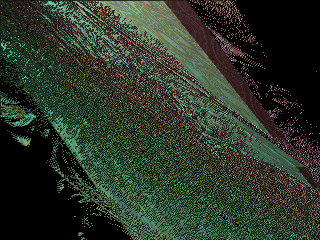 [rfun s=imaj(z) p=sin(x#) q=sin(y#) r=e^p t=e^q rend z=x#+r*cos(y#)*cos(s)*i+t*cos(y#)*sin(s)*j+r*sin(y#)*k+0.0*c This reformulation removes a procedural error on my part and compensates for the increase in processing time. The following is the corrected strain ellipse envelope , but quasz shows no solid platform is produced except in this one special arrangement! [rfun s=imaj(z) p=1/sin(x#*pi/y#) q=1/sin(1#*pi/y#) r=e^p t=e^q rend z=x#+r*cos(y#)*cos(s)*i+t*cos(y#)*sin(s)*j+r*sin(y#)*k+1.0*c |
|
|
|
« Last Edit: May 01, 2013, 01:27:56 AM by jehovajah, Reason: Add sculpture »
|
 Logged
Logged
|
May a trochoid of ¥h¶h iteratively entrain your Logos Response transforming into iridescent fractals of orgasmic delight and joy, with kindness, peace and gratitude at all scales within your experience. I beg of you to enrich others as you have been enriched, in vorticose pulsations of extravagance!
|
|
|
|
jehovajah
|
 |
« Reply #12 on: May 02, 2013, 04:24:27 AM » |
|
I think Matts methods here www.fractalforums.com/theory/an-old-formula-revised/90/May be useful in getting the streamlines to move relative to each other. http://my.opera.com/jehovajah/blog/2013/05/01/standing-waves-and-the-strain-ellipsoidThere is an unfamiliar concept of wave here, not based on the unit circle, but on the strain ellipse. It reminds me of De Brogelie waves and Milo Wolff's standing wave theory, http://www.quantummatter.com/ |
|
|
|
« Last Edit: May 02, 2013, 04:45:51 AM by jehovajah »
|
 Logged
Logged
|
May a trochoid of ¥h¶h iteratively entrain your Logos Response transforming into iridescent fractals of orgasmic delight and joy, with kindness, peace and gratitude at all scales within your experience. I beg of you to enrich others as you have been enriched, in vorticose pulsations of extravagance!
|
|
|
|
jehovajah
|
 |
« Reply #13 on: May 02, 2013, 11:23:09 AM » |
|
a local reference frame is necessary to describe deformation of an object posseesing that local frame. While the shape of an object can be described in an external reference frame it makes more sense proprioceptively to describe it against a local one, as this seems to be the way the brain processes distinguished objects.
Because of his tendency, i can observe that certain seemingly definite objects are in fact artifacts of this brain processing Tendency, especially in dynamic situations. The tendency seems to be to boundarise a form, however indefinitely, relative to a polar coordinate referene frame. The geometric centre of the "image" is not usually emphasised, but is known proprioceptively. Sometomes this corresponds with a centre of symmetry in the form, other times centre of dynamic dynamic symmetry, such as a barycentric centre. This determination, because of the iteration process in perception, only needs to be a rough guess, as within nanoseconds the true centre is converged upon as the image dynamics stabilise.
The strain ellipsoid provides a boundarisation surface that is dynamic but it does not interact with its suroundings. This requires the envelope of the strain eelipsoids as they progress through vorticity. To this may be added any translation caused by normal and vorticity stream pressures.
Since the strain eelipsoid contains a measure of vorticity the question is do we need vorticity streams? I think so because of the situation of being scale free or fractal as a requirement i have imposed.
|
|
|
|
|
 Logged
Logged
|
May a trochoid of ¥h¶h iteratively entrain your Logos Response transforming into iridescent fractals of orgasmic delight and joy, with kindness, peace and gratitude at all scales within your experience. I beg of you to enrich others as you have been enriched, in vorticose pulsations of extravagance!
|
|
|
|
jehovajah
|
 |
« Reply #14 on: May 03, 2013, 05:28:28 AM » |
|
for vectors a,b,c if c ~ a+b (That is c is a label to a+b because they both have common beginning and end points) Then the strain deformation vector ∂c ∂c =mod(exp(1/[a x b]))c where [a x b] is the cross product of the two vectors or the wedge product, that is the area of the paralelogram formed by the 2 vectors. This defines the strain behaviour between 2 points identified by c, and by a + b. This can be written in terms of unit vectors, which make plain that a,b,c are fixed but ∂c is ≠ c As the unit vectors are varied ∂c varies, so dynamic , iterative function form can be written to model strain behaviour. Let dc be a vector type dc :=b means set dx as b and treat as a vector. Then iterate dc:=a+dc dc:=a+mod(exp(1/[a x dc]))dc Finally ∂c:=dc It is important to note that this is a wave function of a different form to the sine one and produces sanding wave patterns relative to the initial point and end point of c. http://www.math.utah.edu/~gustafso/s2012/2270/web-projects/christensen-HistoryLinearAlgebra.pdf |
|
|
|
« Last Edit: May 03, 2013, 09:56:05 AM by jehovajah »
|
 Logged
Logged
|
May a trochoid of ¥h¶h iteratively entrain your Logos Response transforming into iridescent fractals of orgasmic delight and joy, with kindness, peace and gratitude at all scales within your experience. I beg of you to enrich others as you have been enriched, in vorticose pulsations of extravagance!
|
|
|
|


















